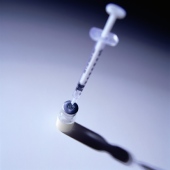
THURSDAY, Aug. 19 (HealthDay News) — More American teenagers are getting their recommended vaccinations, federal health officials reported Thursday.
In some cases the number of teens getting the shots increased 15 percent from 2008 to 2009, according to the U.S. Centers for Disease Control and Prevention.
“This is the nation’s report card on how the nation is doing in protecting adolescents and teenagers from vaccine-preventable diseases,” said Dr. Lance Rodewald, director of the Immunization Services Division of the CDC’s National Center for Immunization and Respiratory Diseases. “It is very important to vaccinate and protect adolescents from vaccine-preventable diseases.”
This year, similar to last year, coverage is rising for the three most routinely recommended vaccines for teens, Rodewald said.
The three vaccines are Tdap, the tetanus-diphtheria-acellular pertussis (whooping cough) booster; the meningococcal conjugate vaccine (against meningitis); and for girls, the human papillomavirus (HPV) vaccine, which fights cervical cancer.
Rodewald noted that all these vaccines are relatively new and it takes several years for coverage of new vaccines to reach the goal of 90 percent.
Tdap is a new vaccine that is replacing the Td booster, adding in the whooping cough component, Rodewald said.
This is the fourth year the CDC has issued a teen vaccine report, and the rates of coverage have risen each year, Rodewald added. “This year they went up about the same amount they went up last year,” he said.
The researchers collected data on more than 20,000 children aged 13 to 17 who took part in the 2009 National Immunization Survey-Teen. The findings were published in the Aug. 20 issue of the CDC’s Morbidity and Mortality Weekly Report.
Other key findings:
- The number of teens who got the Tdap shot rose 15 percent, to 56 percent overall.
- 54 percent of teenagers got one dose of meningococcal conjugate vaccine, an increase of about 12 percent.
- 44 percent of girls got at lease one dose of the HPV vaccine, an increase of 7 percent.
- 27 percent of girls got the recommended three doses of HPV vaccine, up 9 percent.
- More than 89 percent of teens had the MMR (measles, mumps, rubella) vaccine, the same as in 2008.
- Vaccination for hepatitis B increased from about 88 percent in 2008 to near 90 percent in 2009.
One factor that may be dampening teen vaccination rates is that many teens don’t see their doctor as often as younger children do, Rodewald said.
“Infants have an advantage in that they have these well-defined child-care visits that gives a natural platform for vaccination, and adolescents don’t make quite as many visits to the doctor,” he said.
Vaccination coverage also varied by states. For example, only Connecticut, Massachusetts, New Hampshire and Rhode Island had more than 60 percent coverage for all three routinely administered adolescent vaccines — Tdap, meningococcal vaccine and HPV, according to the report.
“For every one of these vaccines there is an enormous range across the states,” Rodewald said. “Some of the states are quicker out of the gate to adopt a new recommendation.”
Meningococcal vaccine coverage ranges from 20 percent in the U.S. Virgin Islands to almost 80 percent in the District of Columbia, and Tdap coverage ranges from 34 percent in the U.S. Virgin Islands to 72 percent in Wisconsin and New Hampshire.
More information
For more on vaccines, visit the U.S. Centers for Disease Control and Prevention.

